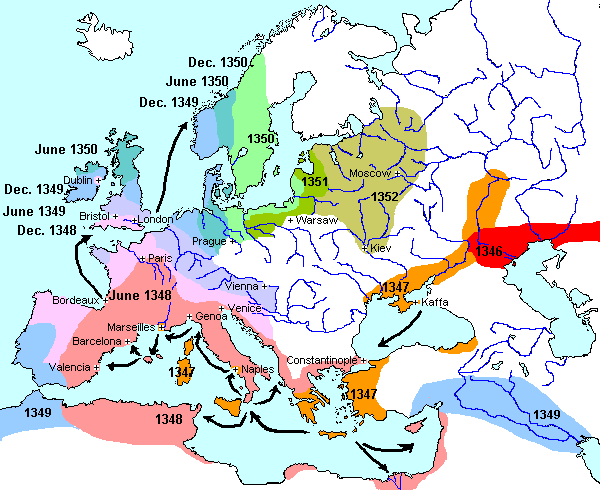Geography Pages
Map of Europe and the Black Death
All boundaries, and borders of countries, are approximate
The territory controlled by a king or people varied from time to time, and was often disputed by other peoples.
The dates and ranges of the Black Death are approximate. People were often reluctant to report cases of Plague in their families, or were unable to do so because they died within a few days of contracting the disease.
An approximation to the modern coast-line is generally used in the maps.
 |
![]() Timeline of Events
Timeline of Events
The timeline includes earlier outbreaks of epidemics which were probably due to Pasteurella pestis / Yersinia pestis (the bacillus which causes Plague). There is some ambiguity, because in earlier times the word "plague" was used for several contagious diseases, and medical knowledge was not advanced enough to be able to make a full diagnosis.
| ca. 1100 BC | The Philistines were hit by a plague which caused swellings (buboes) in the groin, and which seems to have been associated with rats or mice. (I Samuel 5:6-21) The Philistines lived in the coastal regions of Canaan, and were probably engaged in sea-trade, which is one of the ways in which Plague is spread. The King James' Version of the Bible describes the swellings as "hemorrhoids" - but people don't usually die from hemorrhoids |
| 430 BC | Plague in Athens killed about 300,000 people, including the Greek leader Pericles. Thucydides survived, and wrote a description of the symptoms |
| AD 541-544 | The First recorded Pandemic (widespread epidemic) of Plague, also known as the Plague of Justinian, which apparently originated somewhere in Africa, spread to Egypt, and then followed the maritime trade routes to Alexandria, Antioch, Constantinople, Rome, Marseilles, and parts of Spain, southern France and the north coast of Africa |
| AD 557-767 | 14 successive epidemics of Plague which followed much the same course as the First Pandemic. Bede recorded outbreaks of a plague in England in the years 664, 672, 679, 683 |
| 1338-1339 | Inscriptions on tombstones in Nestorian cemeteries in central Asia indicate that people there had died of Plague (D. A. Chwolson, reported in Encyclopedia Britannica article "Plague") From that region it spread to Mongolia, China, India, and eventually Europe |
| 1347 | The start of the Black Death - The Kipchak Mongol army under Khan Janibeg probably picked up an infection of Plague from China or central Asia. Janibeg was besieging the town of Kaffa in the Crimea when his army started dying around him, so he used the corpses of his men as missiles to catapult over the walls of Kaffa and infect the town. Kaffa was a trading post for Genoese merchants, and some of them took ship and fled. They were already infected, and the Plague went with them to Constantinople. In October, infected Genoese ships arrived at Messina in Sicily, continued to Naples and Genoa in Italy, and then to Marseilles in France. The Plague also jumped to Corsica and Sardinia. |
| 1348 | The Plague spread from Sicily to northern Africa and to the ports on the Adriatic (Venice and Ragusa). From Marseilles it followed the trade routes to Spain, and also penetrated southern France. In August 1348 a ship from Calais brought the Plague to Dorset in England. Other ships from Bordeaux carried Plague to Bristol and London. From Constantinople, ships carried the Plague to Alexandria and Cairo in Egypt |
| 1349 | Those fleeing from plague-ridden areas carried the infection with them - whole villages and towns were infected and wiped out, as the plague traveled down the Rhine valley, to Germany, Austria, Hungary, Switzerland. Plague spread rapidly through Britain, and also came by an infected ship to Norway. In the Middle East, the Plague spread from Egypt to Mesopotamia and Persia, reaching Mecca and Baghdad |
| 1350-1351 | The Plague spread from Norway to Sweden and then into Russia |
| 1361-1636 | Throughout Europe and the Middle East there were sporadic outbreaks of plague, about once every generation |
| 1665-1666 | The Great Plague of London - the English blamed it on the French, but it may have come from Holland, where there had been several outbreaks. Between 75,000 to 100,000 people died in London. The death rate was slackening, when the Great Fire of London broke out in September, 1666. The fire destroyed the central part of London where there were infestations of rats and fleas. After the city was rebuilt and better sanitation introduced there was much less incidence of plague |
| 1709-1711 | Plagues in Sweden and Russia |
| 1720-1738 | Plagues in Marseilles, Eastern Europe |
| 1771 | Plague in Moscow |
| 1882-1912 | The Third Pandemic, started in China, spread to India, S. Africa, Hawaii, the USA (San Francisco), Australia, Russia, S. America |
| 1894 | Alexandre Yersin identified the cause of Plague as the bacillus now known as yersenia pestis or pasteurella pestis |
| 1898 | Paul-Louis Simond, a French doctor, proved that Plague occurred in rats and was spread by rat fleas |
![]() Go here for the History of the period.
Go here for the History of the period.
Copyright © 1999 Shirley J. Rollinson, all Rights Reserved